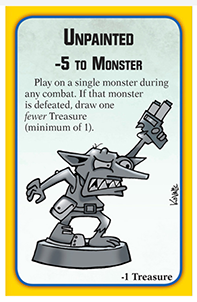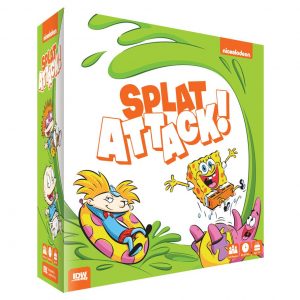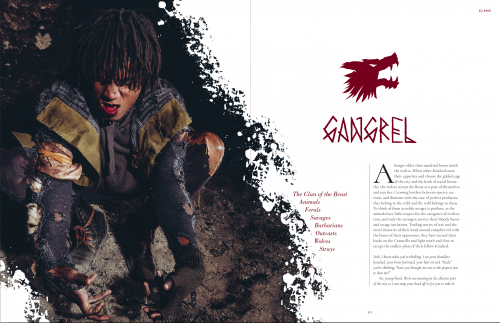Licensed to Play
21 Sep
Posted by David Miller as Card Games, CCGs, Electronic Games, Miniatures, Modern Board Games, RPGs, War Games
 Hasbro is partnering with Epic Games to produce Fortnite-based toys and games. Of course, there’s to be a Fortnite Monopoly (due this fall) but also other unspecified games.
Hasbro is partnering with Epic Games to produce Fortnite-based toys and games. Of course, there’s to be a Fortnite Monopoly (due this fall) but also other unspecified games.
Shinobi 7 announced acquisition of the Conan license for tabletop games. Two products are planned. The first, a miniatures game via Kickstarter project. The second, a direct-to-retail card game.
With a license from Sony Interactive, Steamforged Games is pursuing plans for a miniatures-heavy Horizon Zero Dawn board game via Kickstarter. Pledges already total more than $1 million, though Steamforged estimates delivery not until March 2020.
Things from the Flood is a just-launched Kickstarter RPG project that’s a sequel to Tales from the Loop and based on another of Simon Stålenhag’s art books. The new one from Free League Publishing is more grim and bleak than its predecessor.
Coming to Kickstarter on the 1st of October is The Hunger Games: Mockingjay from River Horse.
 Then scheduled for November 13th is Assassin’s Creed: Brotherhood of Venice from Triton Noir. The company promises a cooperative miniatures game focused on stealth mechanisms.
Then scheduled for November 13th is Assassin’s Creed: Brotherhood of Venice from Triton Noir. The company promises a cooperative miniatures game focused on stealth mechanisms.
WizKids recently announced a licensing arrangement with WWE. The company will add WWE wrestling personalities to HeroClix and Dice Masters and create WWE board games.
Available now from WizKids is Star Trek Galactic Enterprises, a game in which you play as Ferengi.
Also available now at retail is Munchkin Starfinder. It’s the Munchkin grab-the-loot card game from Steve Jackson Games, based on the Starfinder sci-fi RPG from Paizo Publishing.
 Next up for Munchkin is Munchkin Warhammer 40,000 based on the property from Games Workshop. I love the meta of this previewed card, Unpainted.
Next up for Munchkin is Munchkin Warhammer 40,000 based on the property from Games Workshop. I love the meta of this previewed card, Unpainted.
But Steve Jackson isn’t the only company with a new Warhammer 40,000 license. Devir has made a racing game, Gretchinz, out of the property. WizKids has adapted Warhammer 40K to Dice Masters in Battle for Ultramar. Ulisses did Wrath & Glory, a Warhammer 40,000 roleplaying game. And USAopoly has made Warhammer 40,000 Monopoly.
Based on Warhammer Age of Sigmar, PlayFusion recently launched Champions, a collectible card game with an online play option. A non-collectible card game, Warhammer Doomseeker is available from Ninja Division.
EN Publishing, under license from Rebellion, is launching a Judge Dredd and the Worlds of 2000AD roleplaying game on Kickstarter.
 IDW will ship to retail this coming February Nickelodeon Splat Attack!, as well as an expansion, Reptar Rampage. The game represents a food fight between teams of characters from various Nickelodeon shows, including Spongebob Squarepants, Hey Arnold!, Rugrats, and Invader Zim.
IDW will ship to retail this coming February Nickelodeon Splat Attack!, as well as an expansion, Reptar Rampage. The game represents a food fight between teams of characters from various Nickelodeon shows, including Spongebob Squarepants, Hey Arnold!, Rugrats, and Invader Zim.
IDW also signed on with Toei Animation for a series of Dragon Ball games. The first two are due in stores this holiday season. Dragon Ball Super: Heroic Battle has players flicking tokens at each other, while Dragon Ball Z: Over 9000 is supposed to provide a more strategic gameplay experience. In 2019 (after a planned Kickstarter campaign), IDW will release a Dragon Ball Z miniatures game.
Coming this fall from USAopoly is the Dragon Ball Z Power Up Board Game in 3D. Also scheduled to deliver soon is a new Disney Chess Set celebrating 90 years of Mickey Mouse. Available now is one celebrating 25 years of Tim Burton’s A Nightmare Before Christmas. The company’s latest Monopoly games include Five Nights at Freddy’s Monopoly, Ren & Stimpy Monopoly, and BoJack Horseman Monopoly.
Looney Labs recently released Mary Engelbreit Loonacy, a matching card game with the artwork of Mary Engelbreit.
Dog Might Games is now making officially licensed Vampire: The Masquerade dice trays, storyteller screens, and storage boxes, each with a choice of clan symbol. Orders ship with exclusive V5 loresheets tied to the new Geek & Sundry show, LA by Night.
Elderwood Academy is taking preorders for a Vampire: The Masquerade Spellbook gaming box made from walnut and leather. It also ships with LA by Night loresheets.
- Comments Off on Licensed to Play
 “Thomas, would you like to review Vampire: The Masquerade 5th Edition?” they asked. Would I? I mean, I’ve never played Vampire before. I’ve heard things about it, sure, but played this game that’s been around for over 25 years, a game that changed rpgs, bringing in a new wave of gamers to the hobby? I haven’t. Friends have played it. I’ve seen Kindred: the Embraced. I’ve attempted to play the Jyhad CCG. I’ve thumbed though a few titles in the line over the years such as Hunter: the Vigil, Changeling: the Lost, and Wraith: the Oblivion. I’ve heard of years and years of world building, metaplot, and lore so thick White Wolf killed the line at least once to make it easier for new players to join in.
“Thomas, would you like to review Vampire: The Masquerade 5th Edition?” they asked. Would I? I mean, I’ve never played Vampire before. I’ve heard things about it, sure, but played this game that’s been around for over 25 years, a game that changed rpgs, bringing in a new wave of gamers to the hobby? I haven’t. Friends have played it. I’ve seen Kindred: the Embraced. I’ve attempted to play the Jyhad CCG. I’ve thumbed though a few titles in the line over the years such as Hunter: the Vigil, Changeling: the Lost, and Wraith: the Oblivion. I’ve heard of years and years of world building, metaplot, and lore so thick White Wolf killed the line at least once to make it easier for new players to join in.
So yeah, let’s take this new edition from the position of a completely new player to the World of Darkness. I don’t have many assumptions about the setting or the game apart from you probably start a campaign with a scene as you, a mortal, before becoming a vampire; there are vampires from different bloodlines secretly running things; and there’s an official LARP that is simultaneously awesome and universally hated with a passion that burns like the sun.
I’m also eternally unclear about the differences between White Wolf, CCP Games, Paradox, and Onyx Path, but that’s something else. (This version is created by White Wolf, has graphic design by Free League, and is distributed by Modiphius. Disclaimer: Modiphus is a graphic design/layout client of mine.)
So. What does Vampire: The Masquerade 5th Edition (V5) look like to a first-time player?

Thick. There book is 406 pages long. Do I have to read all of that to play? Open book, Thomas. Dive in.
 The art style of the book is centered around the use of digitally-manipulated photographs, which is… interesting. There are stock photo resources used here and original photographic assets, which is a technique I’ve seen (and used – I do layout and graphic design for other RPGs) in other horror role-playing games set in urban settings during contemporary times. (Chill and Unknown Armies are two I’ve worked on that use this technique, so to me, it doesn’t look like anything out of the ordinary.) The layout is easy to read with a two- or three-column layout per page with plenty of whitespace and room for the copy to breathe. It’s light and open and suddenly those 400+ pages don’t seem like much of a threat.
The art style of the book is centered around the use of digitally-manipulated photographs, which is… interesting. There are stock photo resources used here and original photographic assets, which is a technique I’ve seen (and used – I do layout and graphic design for other RPGs) in other horror role-playing games set in urban settings during contemporary times. (Chill and Unknown Armies are two I’ve worked on that use this technique, so to me, it doesn’t look like anything out of the ordinary.) The layout is easy to read with a two- or three-column layout per page with plenty of whitespace and room for the copy to breathe. It’s light and open and suddenly those 400+ pages don’t seem like much of a threat.
We open with twenty-eight pages of in-world fiction presented as a collection of papers, screenshots on phones, and the like, collaged as if the reader is going through a stack of papers on someone’s desk. It’s very… clean? I recall in earlier editions of World of Darkness games, the front chapters were filled with hard-to-read in-world fiction, scribbles on notebook paper. Here, this serves to be an introduction to what vampires are in the game, that there’s a “masquerade violation” that’s got to be dealt with violently, and what clans are.
Oh, an early example of play before concepts are introduced. This is done rather well. It’s one of the best example of plays I’ve seen. A concept is introduced with a page reference to later in the book. We’re not just reading from a script like so many other games’ examples of play – we have a bit with dialogue, a summary of what’s going on, some decision points our game’s Storyteller is doing, a look at some of the mechanics, and a definite feel of how the game designers believe Vampire is to be run. Here’s a thing: players are adding world-building elements.
Onward: lots of quick overviews of clans and larger groups/movements. Rules seem simple: stat + skill to get a dice pool of ten-sided dice, 6s or higher are successes. Pairs of 10s are even bigger successes: 10s alone aren’t awesome, buckets of them are. You’re rolling against a target number; if you fail you don’t do the thing unless you want to, as long as something bad happens. Perhaps you took damage. Perhaps you were caught on a CCTV camera. Perhaps you didn’t notice you dropped your cellphone right there.
Combat in roleplaying games can take a long time to slog through. Vampire “strongly recommends” that you take no more than three turns to resolve an ongoing conflict. “Too much dice rolling slows down the drama and becomes harder and harder to describe creatively.” There’s an emphasis on getting more story in a game of Vampire than a second-by-second recording of blows and the whittling down of health stats. (Besides, there are plenty of other games for that.)
One third of the way through and it doesn’t feel like the size of the book is imposing. Continue through character creation and we see we’re using relationship maps, so yes, more emphasis on all the players helping to create the world you’re playing in. You should create your characters together, because that’s group play. First, create yourself as a human.
“And then, some monster kills you.”
That sentence is written in red with a lot of space above it and a lot of space below it. Yes, the game earlier did state that you’re not playing good guys in this game, but here, some monster kills you and now you’re going to play a monster.
Halfway through the book and we’re looking at life as a vampire and all the horrible things you must deal with: hunger, power, and your own humanity. A slew of optional rules come in (just in case you do want a blow-by-blow health attrition fight), and then we’re at Cities. Here’s how cities work. Here’s how domains work. Here’s several hunting grounds you might find. Here’s how to make your city into a city run by vampires.
We’re very close to the end of the book. There’s a whole section of Storyteller advice on how to run a game of Vampire. There’s a sample chronicle (campaign setting/storyline). A packet of opponents that might be thrown against your coterie of vampires. And we’re out.
All that lore, all that heavy weight of the past twenty-seven years of canon and metaplot? It’s not here. Just the basics of being vampires. Not a whiff of Werewolves, Hunters, Changelings, Mages, Mummys, or Wraiths. It feels like I, someone who knows nothing about the history of this game, could jump in and start playing a game where we’re all vampires.
So. For a gamer who hasn’t played Vampire, this looks… rather easy to get into.
A pre-release pdf copy of Vampire: The Masquerade 5th Edition was provided free for review by White Wolf.
 White Wolf Entertainment (since November of last year, a subsidiary of Paradox Interactive) has begun development work for a fifth edition of Vampire: The Masquerade. While the company has generally described itself as a story and brand manager, rather than a publisher, in this case it is handling both game development and publishing of the tabletop RPG internally.
White Wolf Entertainment (since November of last year, a subsidiary of Paradox Interactive) has begun development work for a fifth edition of Vampire: The Masquerade. While the company has generally described itself as a story and brand manager, rather than a publisher, in this case it is handling both game development and publishing of the tabletop RPG internally.
At the heart of the new Vampire is the One World of Darkness, which White Wolf describes as a:
Unified theory of the supernatural, not rebooted but revolutionized and reborn in our chaotic time of sweeping change.
Hinting at what that might mean in game terms, Martin Ericsson, White Wolf’s Lead Storyteller and Brand Architect, said at the recent Grand Masquerade convention:
What if you are what you eat? What if you grow through the prey you seek out? What if to disappear from sight, you feed from those we forget and look away from, the homeless, the lost? What if to dominate, you fuel your powers through the blood of those in submission?
One of the issues driving this development appears to be an effort to better coordinate among the many World of Darkness licenses and prepare the property for growth in to other entertainment genres. Besides its hopes for a World of Darkness television show sometime in the future, White Wolf is preparing to release two mobile alternate-reality games this winter.
The Vampire: The Masquerade fifth edition tabletop roleplaying game is slated for release in the winter of 2017-2018.
After that, the company promises that the One World of Darkness metaplot will be heavily influenced by player input.
- Comments Off on Vampire: The Masquerade 5th Edition
Trending
- Massdrop.com
- Oh the Irony—Illuminati Card Game Continues to Inspire Conspiracy Theorists
- Home
- Footprints, an Educational Ecology Game
- USPS Adds Board Game Flat Rate Box
- Baila, the Estonian Drinking Card Game
- Crystal Caste Wins Dice Patent Suit Against Hasbro
- Mirror Game, Red and Blue
- Are Board Games Dangerous?
- The Truth About Dominoes On Sunday in Alabama
Archives
Most Popular Articles
- Oh the Irony—Illuminati Card Game Continues to Inspire Conspiracy Theorists
- The 20 Most Valuable Vintage Board Games
- The Truth About Dominoes On Sunday in Alabama
- Sequence Game, and Variants
- USPS Adds Board Game Flat Rate Box
- Baila, the Estonian Drinking Card Game
- The 13 Most Popular Dice Games
- Are Board Games Dangerous?
- Guess Who? The Naked Version
- What Happened to the Jewel Royale Chess Set?
Recent Posts
- Toy Fair 2019—Breaking Games
- Talisman Kingdom Hearts Edition
- Toy Fair 2019—Winning Moves
- Toy Fair 2019—Games Workshop
- Toy Fair 2019—Star Wars Lightsaber Academy
- Toy Fair 2019—Stranger Things Games
- Toy Fair 2019—HABA
- Licensing Roundup
- Game Bandit
- 2018 A Difficult Year For Hasbro But Not For D&D Or MtG
Recent Comments
- on Toy Fair 2019—Winning Moves
- on Game Bandit
- on Second Look—Dungeons & Dragons Waterdeep Dragon Heist
- on Crowdfunding Highlights
- on Beyblade SlingShock
- on Game Bandit
- on Game Bandit
- on Watch This Game!, the Board Game Review Board Game
- on Second Look—Vampire: The Masquerade 5th Edition
- on Palladium Books Loses Robotech IP License, Cancels Five-Year-Overdue Robotech RPG Tactics Kickstarter






